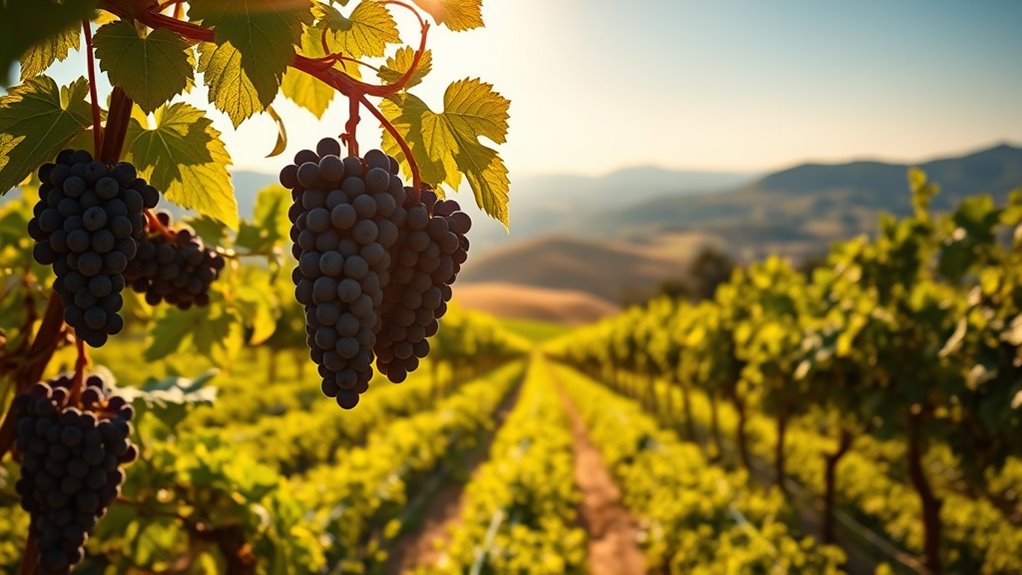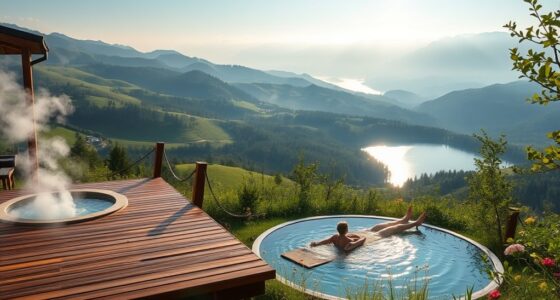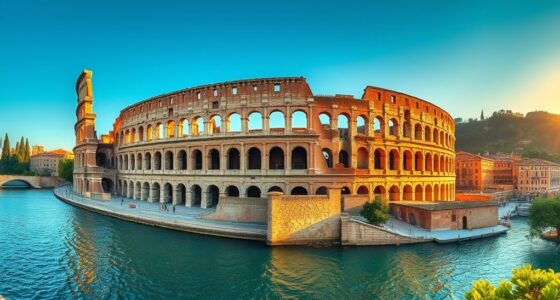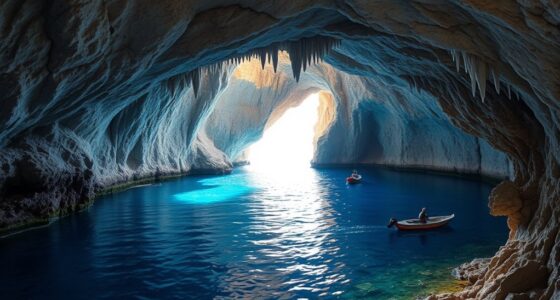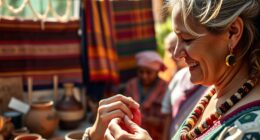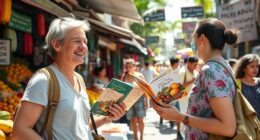The best time to visit Sardinia’s vineyards is late August through September, during the lively harvest season when grapes like Cannonau and Vermentino are picked. This period offers vibrant festivals, scenic autumn foliage, and an energetic atmosphere in the vineyards. If you’re interested in experiencing authentic wine traditions and stunning landscapes, planning your visit around these months will give you the most memorable experience. Keep going to find out more about ideal times and vineyard adventures.
Key Takeaways
- Late August to September offers the best experience for vineyard harvest activities and participating in local grape-picking festivals.
- Spring (April to June) provides lush landscapes, full vine growth, and mild weather ideal for vineyard tours and outdoor exploration.
- Autumn (September to October) features vibrant foliage, scenic landscapes, and fewer crowds, perfect for photography and peaceful visits.
- Summer months host lively wine festivals, tastings, and cultural events, enhancing your vineyard experience.
- Planning around major festivals like Calici di Stelle or Jerzu Wine Festival ensures immersive and authentic Sardinian wine celebrations.
The Peak Harvest Period in Sardinia
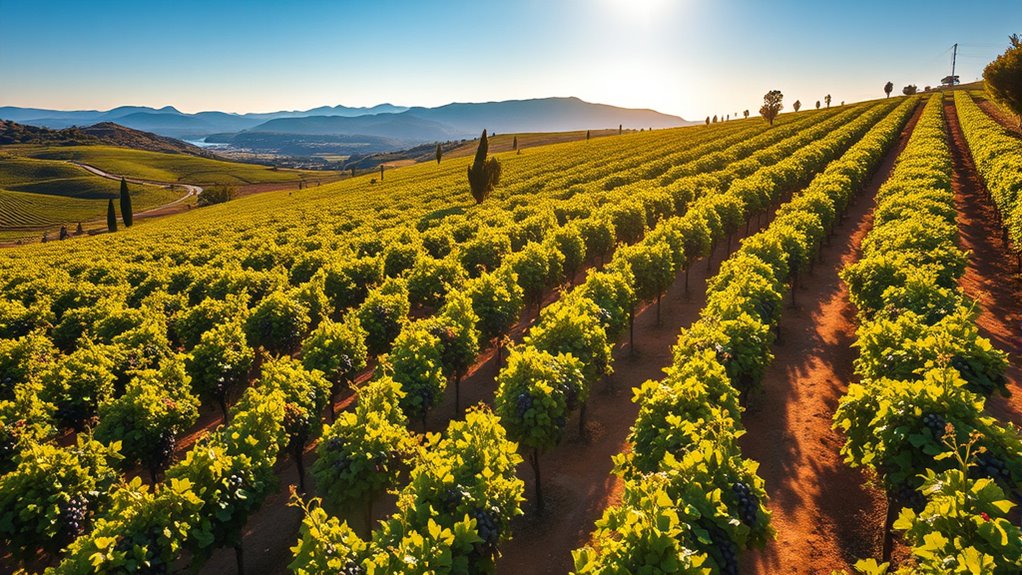
The peak harvest period in Sardinia typically occurs from late August to the end of September, making this the most vibrant and busy time in the island’s vineyards. During this period, you’ll see workers carefully handpicking ripe grapes, especially varieties like Cannonau, Monica, and Bovale, which are harvested later in September or early October. White grapes such as Vermentino are picked earlier, often in September, depending on weather conditions and vineyard location. The timing varies based on altitude, climate, and microclimate factors, meaning some grapes might ripen sooner or later each year. Early ripening grapes intended as table grapes are harvested at the end of August, but the main focus remains on producing premium wines. This lively season is essential for Sardinia’s wine industry and cultural traditions.
Optimal Months for Vineyard Tours and Activities
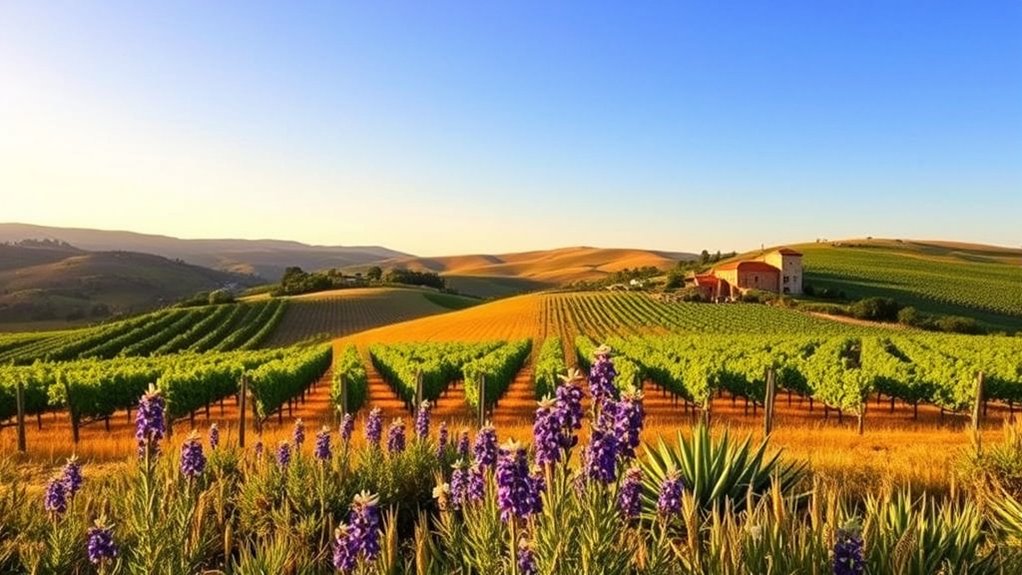
Spring, from April to June, is the ideal time to explore Sardinian vineyards, as you’ll see vibrant foliage and lush green vines in full display. During these months, you can participate in hands-on activities like grape tasting and guided tours without the summer crowds. Plus, the mild weather makes outdoor adventures and vineyard visits both enjoyable and comfortable. Additionally, the vineyard landscapes are at their most picturesque, offering perfect photo opportunities. This season also coincides with the growth cycle of grapes, ensuring the vineyards are at their peak.
Peak Harvest Season
Late summer to early fall marks Sardinia’s peak harvest season, making it the best time for vineyard tours and activities. During this period, the vineyards come alive with bustling grape picking, especially from late August to September. The weather is usually warm and sunny, perfect for outdoor experiences. You’ll witness indigenous varieties like Cannonau and Vermentino being harvested, often by hand in challenging terrains. The harvest is a lively cultural event, blending tradition and commerce. Expect to see:
- Vibrant vineyard scenes with workers handpicking grapes
- Baskets and crates filled with freshly harvested fruit
- Winery staff preparing for pressing and fermentation
- Festive celebrations and local festivals
- Opportunities for early wine tastings with ripe grapes
This season offers an authentic glimpse into Sardinia’s winemaking heritage. Additionally, implementing multi-factor authentication (MFA) can enhance security during vineyard visits where digital transactions or data sharing occur.
Vine Foliage Display
Vineyard tours in Sardinia are especially enchanting when the foliage displays its vibrant hues, typically from September through October. During this time, the leaves turn striking shades of yellow, orange, and red, creating a stunning autumnal landscape. As the vines begin to show signs of senescence, the picturesque scenery offers a perfect setting for photography and leisurely walks. While grape harvesting winds down, the foliage remains lush, providing a warm, scenic backdrop for visitors. The gradual leaf fall signals the end of the growing season, but the colorful displays make this period ideal for immersive vineyard visits. You can enjoy the peaceful ambiance and appreciate the natural beauty that marks the close of Sardinia’s vibrant grape cycle. The changing foliage also highlights the importance of seasonal variations in vineyard landscapes.
Participatory Experiences
The best time to participate in vineyard activities in Sardinia is during the months of April to June when the weather is mild and the vines are in full growth. This period offers ideal conditions for outdoor exploration and hands-on experiences. You can enjoy guided wine tastings, where local experts introduce you to regional varieties. During September and early October, grape harvest activities let you pick and process grapes firsthand. Many wineries also host winemaking workshops and cellar tours, enriching your understanding of traditional and modern techniques. Additionally, you can indulge in culinary tastings featuring local Sardinian foods. For outdoor enthusiasts, spring is perfect for hiking or MTB adventures around vineyards. Overall, these months balance pleasant weather with vibrant vineyard life, making your participatory experience memorable. Participatory experiences during this period provide a unique opportunity to connect more deeply with Sardinian winemaking traditions.
Indigenous Grape Varieties and Their Harvest Times
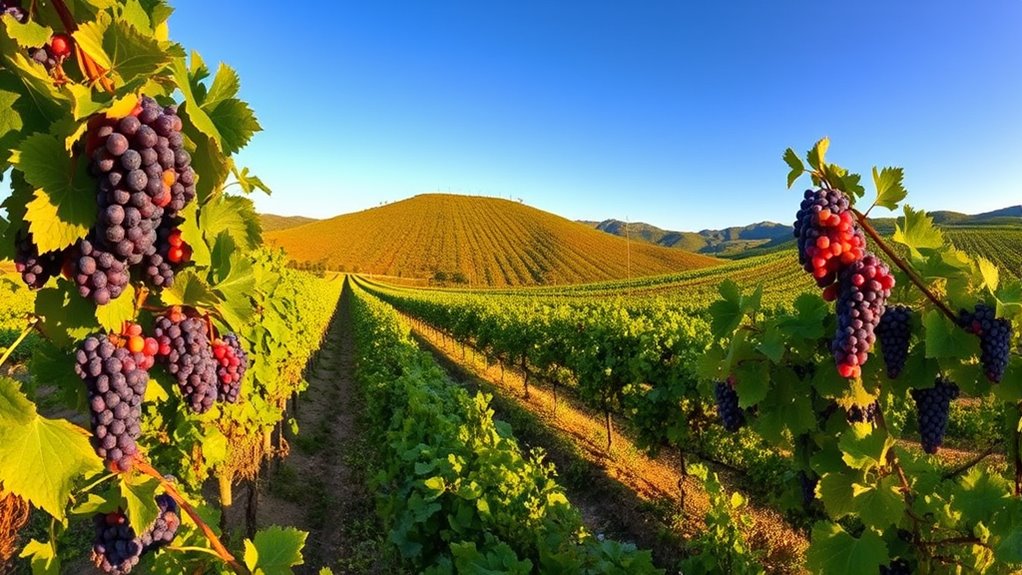
Sardinia’s indigenous grape varieties each have specific harvest times that reflect their unique characteristics and growing conditions. You’ll find reds like Cannonau and Carignano ripening late September to October, needing extra hang time for flavor development. Monica and Girò usually harvest from mid to late September, depending on vintage conditions. Lesser-known varieties like Nieddera and Pascale are typically harvested in September as well. For whites, Vermentino is picked in late August to early September, aiming to preserve freshness and aromatics. Nuragus, Nasco, Malvasia di Sardegna, and Semidano are harvested from early to mid-September. Factors like climate, altitude, and grape traits influence these timings, ensuring each variety reaches ideal ripeness for distinct wine styles.
| Red Varieties | Harvest Time |
|---|---|
| Cannonau | Late September to October |
| Carignano | Late September to early October |
| Monica | Mid-September to early October |
| Girò | Mid to late September |
| White Varieties | Harvest Time |
| Vermentino | Late August to early September |
| Nuragus | Early to mid-September |
| Nasco | Early September |
| Malvasia di Sardegna | Mid to late September |
Traditional and Modern Harvest Practices
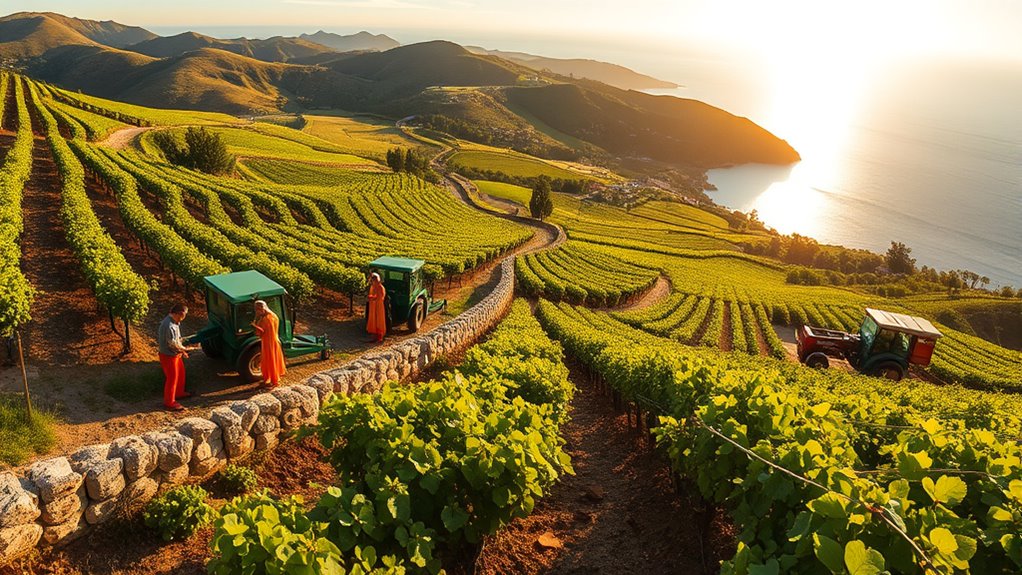
Although modern technology has introduced new methods, traditional harvest practices remain essential to maintaining the quality and cultural heritage of Sardinian vineyards. Hand-picking grapes guarantees only ripe, healthy bunches are selected, especially on steep or older terrains. Many producers still value this skillful approach, despite mechanization becoming more common on flatter vineyards. Traditionally, grapes were transported in crates and crushed by foot in open vats, practices that connect vintners to centuries of heritage. Today, most estates use stainless steel tanks and pneumatic presses, but some small producers preserve artisanal techniques. Preservation efforts focus on integrating organic methods with traditional knowledge. This blend maintains quality and honors Sardinia’s winemaking legacy. Emotional support can be crucial for vineyard workers during intensive harvest periods, ensuring their well-being and sustained craftsmanship.
How Climate Shapes Vineyard Schedules
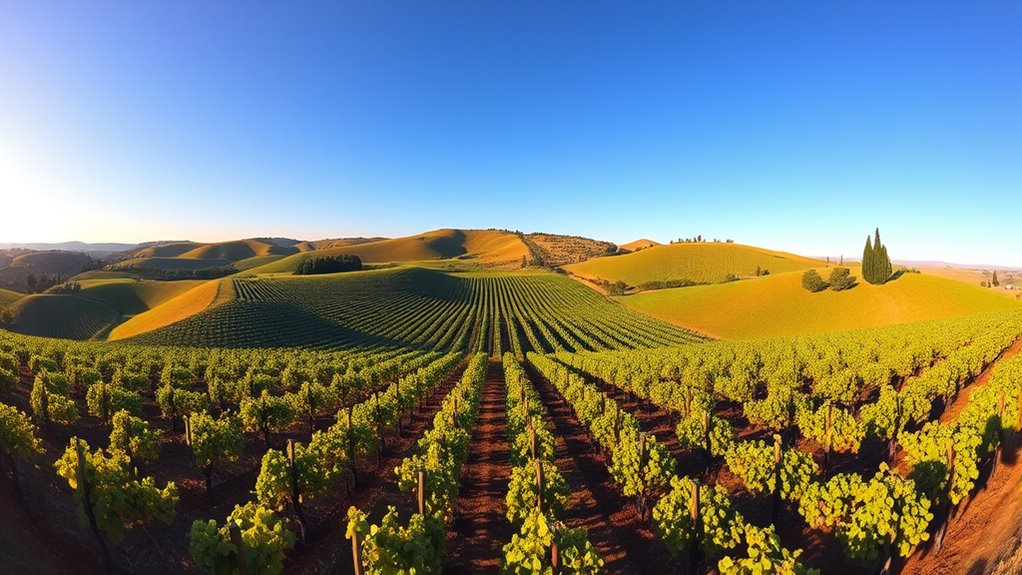
Climate plays a crucial role in shaping vineyard schedules across Sardinia by influencing grape development and harvest timing. The island’s Mediterranean climate, with hot, dry summers and mild, wet winters, creates distinct growing conditions. Coastal vineyards benefit from maritime breezes that moderate temperature swings and humidity, helping preserve acidity and aromatic qualities. Regional microclimates also matter: cooler northern areas favor aromatic whites, while hotter southern plains produce robust reds like Cannonau. Soil types, from granite to limestone, further influence ripening cycles and water stress levels. Rising temperatures and increased droughts due to climate change are pushing harvest dates earlier and stressing vines. As a result, vineyard schedules become more unpredictable, requiring adaptive strategies to maintain quality and balance. Climate variability also impacts pest and disease pressures, necessitating more vigilant vineyard management practices.
Celebrating the Harvest: Events and Festivals
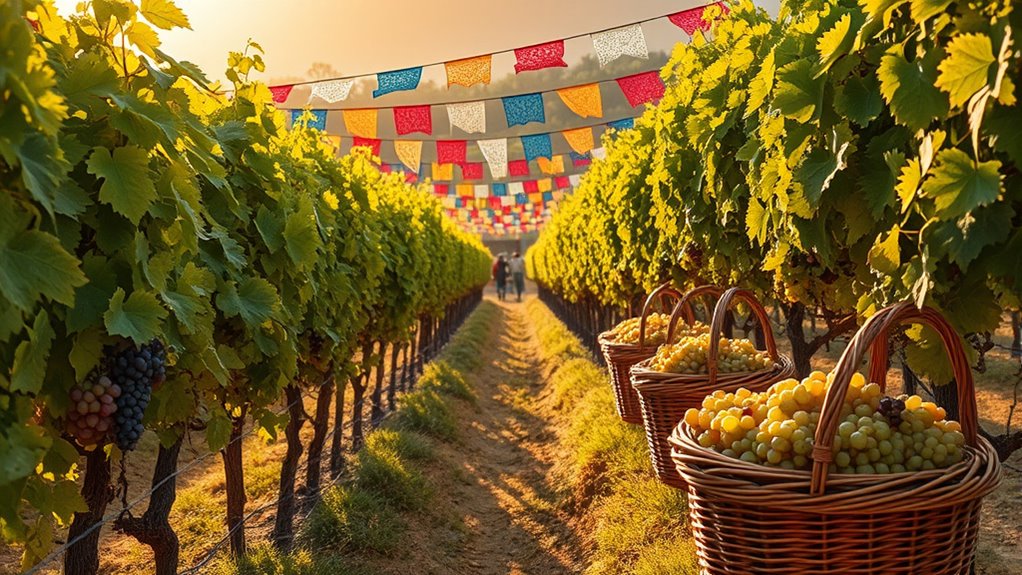
As the harvest season arrives, Sardinia bursts into lively festivals and celebrations that highlight local wines and traditions. You can experience traditional grape picking, lively wine tastings, and cultural events that showcase the island’s rich heritage. These festivals offer a vibrant glimpse into Sardinia’s wine culture and seasonal spirit. One of the most exciting highlights is the Novello Wine Festival in Milis, where visitors can taste fresh, young wines made from the same-year grapes, embodying the Essence of Novello Wine and the spirit of the harvest season. Engaging in these festivities allows visitors to embrace the local customs and deepen their appreciation for Sardinia’s vinicultural traditions.
Traditional Harvest Festivals
Traditional harvest festivals in Sardinia offer a vibrant celebration of the island’s rich agricultural and cultural heritage. During late August and September, these festivals mark the grape harvest with lively events that showcase local traditions. You’ll experience the aroma of freshly picked grapes, traditional music, and colorful costumes. Expect to see:
- Festive wine tastings linked to regional varieties like Cannonau and Vermentino
- Dances, concerts, and horse races that bring communities together
- Stalls featuring Sardinian culinary specialties, promoting local food
- Guided tours highlighting the island’s historical wine-producing sites
- Religious ceremonies rooted in centuries-old customs
These festivals typically feature a variety of traditional crafts and artisanal products, emphasizing Sardinia’s diverse cultural expressions.
Grape Picking Celebrations
Grape picking celebrations in Sardinia bring communities together to honor the harvest season with lively events and colorful traditions. In Sorgono, the Sa Innenna Grape Harvest Festival takes place annually in late October, featuring a lively procession led by an oxcart carrying “Su cuppone” for grapes. Participants often press grapes barefoot and watch demonstrations of must pressing, showcasing local winemaking techniques. The festival also includes educational courses and productions of regional spirits like Abbardente and Muscadeddu. A highlight is the Palio delle Botti, a barrel-rolling race through the old town streets where teams push 225-liter barrels. These celebrations mark the end of the harvest, celebrating Sardinia’s indigenous grape varieties and the vibrant community spirit that surrounds the vineyard season. The festival’s origins date back centuries, reflecting Sardinia’s long-standing seasonal tradition of celebrating the harvest. In addition, the focus on local grape varieties emphasizes Sardinia’s commitment to preserving its unique viticultural heritage.
Wine Tasting Events
Wine tasting events in Sardinia offer a vibrant celebration of the island’s rich viticultural heritage, especially during the spring and early summer months when the weather is mild and inviting. These festivals showcase Sardinian wines through tastings, masterclasses, and gourmet experiences, drawing both locals and international visitors. During Porto Cervo’s Wine & Food Festival in early May, you can enjoy curated tastings, meet renowned chefs, and explore Mediterranean flavors in a luxurious setting. In early July, Alghero’s Wine Week immerses you in Sardinian culture with lively music, cultural events, and interactive wine experiences. Bosa’s Wine Festival in late May offers scenic coastal tastings and cultural immersion. These events blend wine, food, music, and tradition, making them perfect for deepening your appreciation of Sardinian wine heritage. These festivals typically take place during the peak harvest season, providing an authentic taste of the island’s viticultural bounty. Visiting during these times also allows attendees to experience the best quality grapes at their peak ripeness, ensuring a memorable tasting experience.
Participating in Vineyard Harvesting Experiences
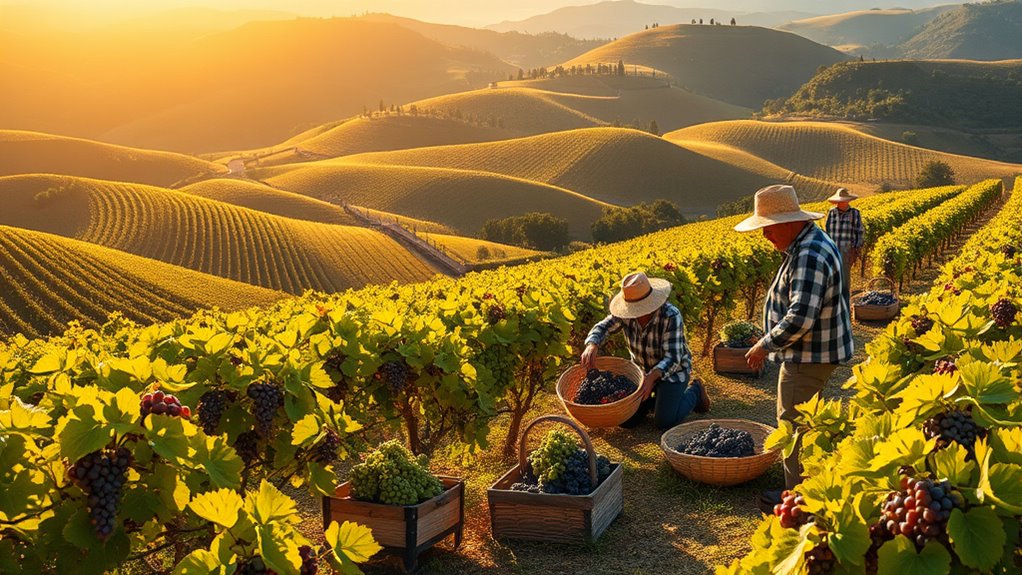
Participating in vineyard harvesting experiences in Sardinia offers an authentic glimpse into the island’s rich wine culture. During late August to September, you can join local farmers in hand-picking grapes like Cannonau, Vermentino, and Carignano. Many vineyards welcome tourists to partake in manual harvesting, giving you a firsthand look at traditional methods and the importance of ripeness. These experiences often include winery tours, where you learn about fermentation and winemaking, and tastings that highlight regional flavors. The harvest is also a lively cultural event, with social gatherings celebrating Sardinia’s wine heritage. Be prepared for physical activity and variable weather, and book in advance to secure your spot. Participating not only enriches your understanding but also supports local communities and preserves enduring traditions. Vineyard practices are integral to maintaining the quality and authenticity of Sardinian wines. The harvest period in Sardinia typically occurs in September and October, aligning with seasonal agricultural practices and climate conditions.
The Aesthetic Appeal of Autumn in Sardinian Vineyards
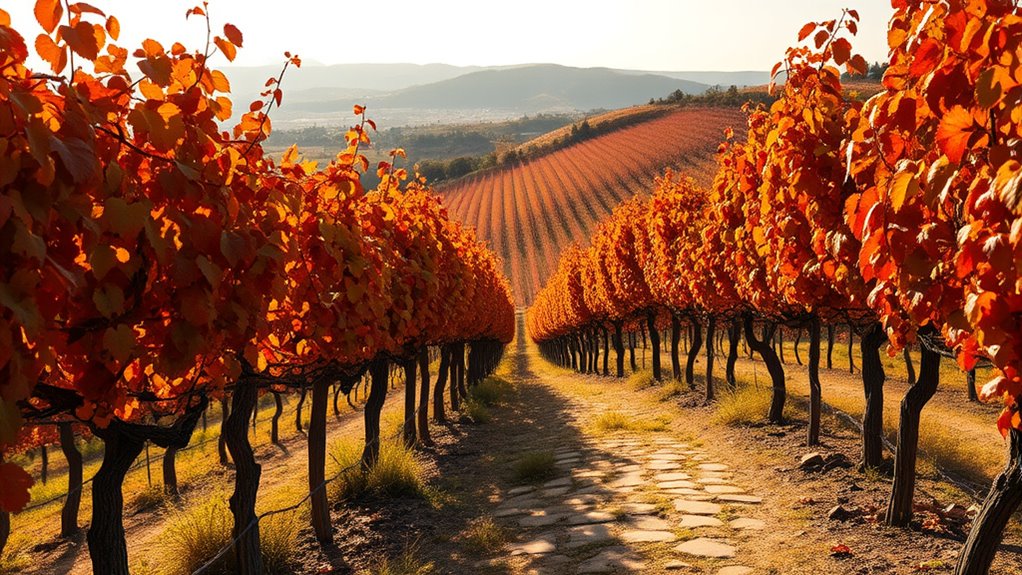
Autumn transforms Sardinian vineyards into a breathtaking tapestry of colors, offering you a vivid and picturesque landscape. As the leaves change, the vineyards burst into shades of red, orange, and gold, creating stunning backdrops. This season also aligns with the grape harvest, adding activity and vibrancy to the scenery. Festive local events and harvest celebrations further enhance the lively atmosphere. Autumn’s softer sunlight provides ideal lighting for capturing the scenery and the vibrant foliage. The cooler temperatures make outdoor exploration comfortable, and fewer tourists mean a more peaceful experience. You’ll find countless opportunities for striking photography, from the colorful foliage to the lush grapevines. Autumn’s natural transformation makes Sardinian vineyards irresistibly beautiful, inviting you to immerse yourself in their seasonal charm.
- Vibrant reds, oranges, and golds in the landscape
- Active harvest season with bustling vineyard scenes
- Festive events and local celebrations
- Soft, warm sunlight ideal for photos
- Serene, less crowded vineyard visits
Planning Your Visit Around the Best Wine and Cultural Events
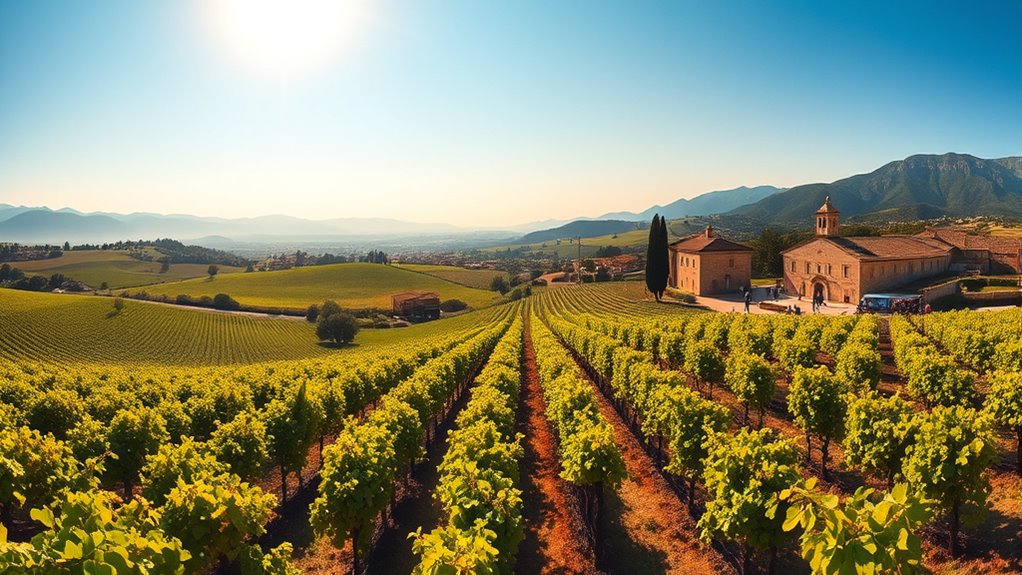
Planning your visit around Sardinia’s vibrant wine and cultural events guarantees you experience the island’s rich traditions at their liveliest. Festivals like Calici di Stelle transform towns into open-air tastings under the stars, while Vite e Vite in Gallura offers intimate winemaker meetings. August’s Jerzu Wine Festival spotlights Cannonau, and Monti’s Vermentino Festival celebrates this unique grape. You can also explore open wine cellars paired with music in various towns.
| Event | When | Highlights |
|---|---|---|
| Calici di Stelle | Summer (August) | Star-lit wine tasting |
| Vite e Vite | May | Artisanal wines, winemaker meetups |
| Jerzu Wine Festival | First weekend August | Cannonau tasting |
| Saboris Antigus | October-December | Cultural and agricultural traditions |
Frequently Asked Questions
What Are the Best Months for Vineyard Photography in Sardinia?
You should visit Sardinia’s vineyards in late spring or early autumn for the best photography. During these months, the weather stays mild and stable, with clear skies and soft, golden light, perfect for capturing vibrant greens or autumn hues. May, June, September, and October offer less crowding and ideal conditions—less heat, longer daylight hours, and stunning scenery—making your vineyard photos truly stand out.
Can Visitors Participate in Grape Harvest Activities?
You can definitely participate in grape harvest activities in Sardinia. Usually, the harvest runs from mid-September to early October, with some varieties picked earlier. You’ll get to actively pick grapes, learn about ripeness, and join winery tours. Many vineyards welcome visitors for hands-on experiences, offering a chance to immerse yourself in local traditions. Just remember to book in advance, as spots can fill up quickly during this vibrant seasonal event.
How Does Weather Variability Affect Harvest Dates Annually?
You might find that harvest dates in Sardinia shift unexpectedly each year due to weather variability. Hotter temperatures and droughts often cause grapes to ripen earlier, sometimes by over a week, while cooler, wetter years delay harvests. Sudden frosts or storms add further unpredictability. As a visitor, you’ll notice these changes influence when vineyards pick grapes, making each vintage a unique experience shaped directly by the climate’s whims.
Are There Specific Festivals Celebrating the Grape Harvest?
You’ll find that Sardinia hosts vibrant festivals celebrating the grape harvest, like La Vendemmia and Calici di Stelle. During these events, locals and visitors come together to harvest grapes, enjoy traditional music, and taste local wines. These festivals highlight Sardinian culture and history, creating an energetic, communal atmosphere. Participating in them gives you a unique chance to experience the island’s rich wine heritage while immersing yourself in lively celebrations.
Which Vineyards Offer Guided Wine Tastings During Harvest Season?
You might worry about limited options, but many Sardinian vineyards offer guided tastings during harvest season. Antichi Poderi Jerzu invites you to participate in grape picking and tasting, while Carignano vineyards focus on education about terroir. Agriturismos combine local food with wine tastings, and festivals near Oristano and Montiferru feature celebrations and tastings. These experiences deepen your understanding of Sardinian wines and make your visit truly memorable.
Conclusion
So, when’s the best time to explore Sardinia’s vineyards? The answer unfolds as you plan your trip—each month revealing a new chapter in the island’s rich wine story. Will you arrive during the bustling harvest festivals or the tranquil autumn landscapes? The secrets of Sardinia’s vineyards await your discovery. Decide your moment, and let the vineyard’s magic captivate you—just don’t wait too long, or the perfect experience might slip away.
